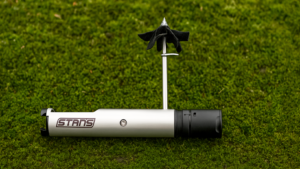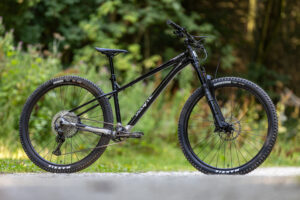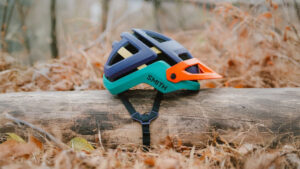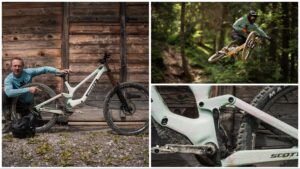The MTe is Yeti's new e-bike, with an updated motor from TQ with more power, more torque, and a stealthy profile. But with only 350W and an £11k price tag, it needs to be really good.
Yeti’s new MTe doesn’t have the hottest e-bike motor, and needs a few mods to unlock its full potential, but I couldn’t help falling for its brilliant suspension
Yeti’s new MTe e-bike comes with only 145mm of travel, unfashionable 29in wheels, and a puny motor (compared to the DJI Avinox). Has this iconic brand misread the room, or is there more to the MTe than meets the eye?

Easy on the eye – the new Yeti MTe is a fine looking e-bike.
Yeti MTe need to know
- Yeti’s second only e-bike gets a brand new TQ motor with 60Nm/350W
- 145mm travel paired with 160mm fork and 29in wheels front and rear
- 580Wh internal battery is removable – options for 160Wh range extender or 290Wh internal battery
- New colour display and upgraded app with customisable modes
- Full carbon frame with Sixfinity suspension design
- Flip-chip geo adjustment can also be used to compensate for 27.5in rear wheel, along with progression adjustment chip
- Room for a water bottle or range extender
- Four frame sizes (from S to XL) and two build options (the T4 is not available in the UK), with prices starting at £9,499 and going to £10,999
– Short of time? Click here to skip to the verdict –
Yeti could be considered the Liverpool Football Club of the mountain bike world. A marque with a long history, deeply loyal fans, and a propensity to win big and lose big. By ‘win big’ I mean bikes like the sublime SB150, SB165, and SB120. And by ‘lose big’, I’m thinking of the short, steep, and conservative SB115 and ARC, and the mediocre 160E – a bike that was late to the e-bike party, and forgot to bring any booze.

Subtly different – the Yeti MTe bears more than a passing resemblance to the older 160E.
This is only Yeti’s second e-bike – rare when plenty of brands are in double figures – but it needs to be something special. Not only as redemption for the lacklustre 160E, but because the shortlist of best e-bikes has been turned upside down with the introduction of a certain lightweight, high power motor with cutting-edge tech and a reasonably-priced e-bike that no one had even heard of a year ago.

Who hasn’t got a soft-spot for a drifting sasquatch?
To the MTe then, and I was convinced that Yeti would be one of the flurry of legacy brands to launch a DJI Avinox-equipped bike in 2025 alongside Unno and Forbidden. I thought this for one simple reason – the 160E was so long in the tooth that updating it with a DJI motor wouldn’t have killed the value of any remaining stock in the market. The timing looked perfect – Yeti had a bike that was overdue for a revamp, and DJI had the hot new motor just begging to be plugged into it.

The new TQ HPR60 motor is a real step forward in performance, but it’s a long way off a full-fat motor on overall assistance.
As is no doubt obvious by now, that isn’t what happened, and the new MTe actually gets TQ’s brand new HPR60 drive system – read our news story about the new TQ motor here. Of course my job is to contain my disappointment and focus on the bike in hand. Is it any good? And has TQ improved the weakness of its system – namely power and range?

The Sixfinity suspension design returns as there’s still not enough space above the motor to use the Switch Infinity system.
Frame
Genetically, the new MTe shares much of its DNA with the 160E. The frame uses a similar layout, the same Sixfinity suspension system, and comes equipped with 29in wheels front and rear. Where the two diverge significantly are in travel, and intended use.
Originally designed for e-enduro racing, the 160E has 160mm of travel with a 170mm fork, while the MTe gets 145mm of travel, a 160mm fork, and is more aimed at all-mountain riding.

A head badge steeped in history.
There is only one carbon frame option, despite the confusing C and T nomenclature usually signalling two different layups. But something new to Yeti’s commercial offering is the use of Vectran fibres within the layup in critical areas. This Kevlar-like fibre improves the overall strength and impact resistance of the frame, and has been trialled by Yeti on its DH frame.

The little mudguard aims to catch some of the flying muck before it collects on the lower link pivots.
Suspension
Once again, Yeti has employed its e-bike-friendly Sixfinity six-bar linkage on the MTe. This was devised to mimic the characteristics of the Switch Infinity link used on the brand’s conventional bikes, while fitting around the extra bulk of a motor. And even the TQ’s impressively discreet dimensions don’t create enough room to allow Yeti to package the Switch Infinity sliding pivot in the right place.

There’s very little to complain about when it comes to the suspension, and plenty to celebrate.
While the Sixfinity connecting links aren’t quite as sleek visually, they do a very similar job, effectively manipulating the anti-squat curve through the travel to keep the suspension taut and efficient when pedalling, while improving freedom and reducing pedal kickback deep in the travel. I won’t go into it too much here, but there’s a dramatic fall away in anti-squat around 2/3 of the way through the travel. Of course there are graphs to back it up, and I am pleased to see that Yeti actually publishes the anti-squat curves for the whole gear range, not just one single ratio, as some brands do.

Flipping the orientation of the lower shock chips changes the overall progression ratio. This is the stock, lower progression setting.
Talking of curves, Yeti gives multiple progression settings, allowing you to choose from two different leverage curves. Moving the lower shock mount forward with the offset chip reduces the progression (12% overall), and moving it back increases the progression (23%). I left it in the least progressive setting during my time with the bike, as I found I was only getting full travel on big, flat landings. So while that 145mm of travel seems measly when pretty much everyone else is positioning their all-mountain e-bikes at 150mm, on the trails, I never found myself wanting for that extra 5mm.
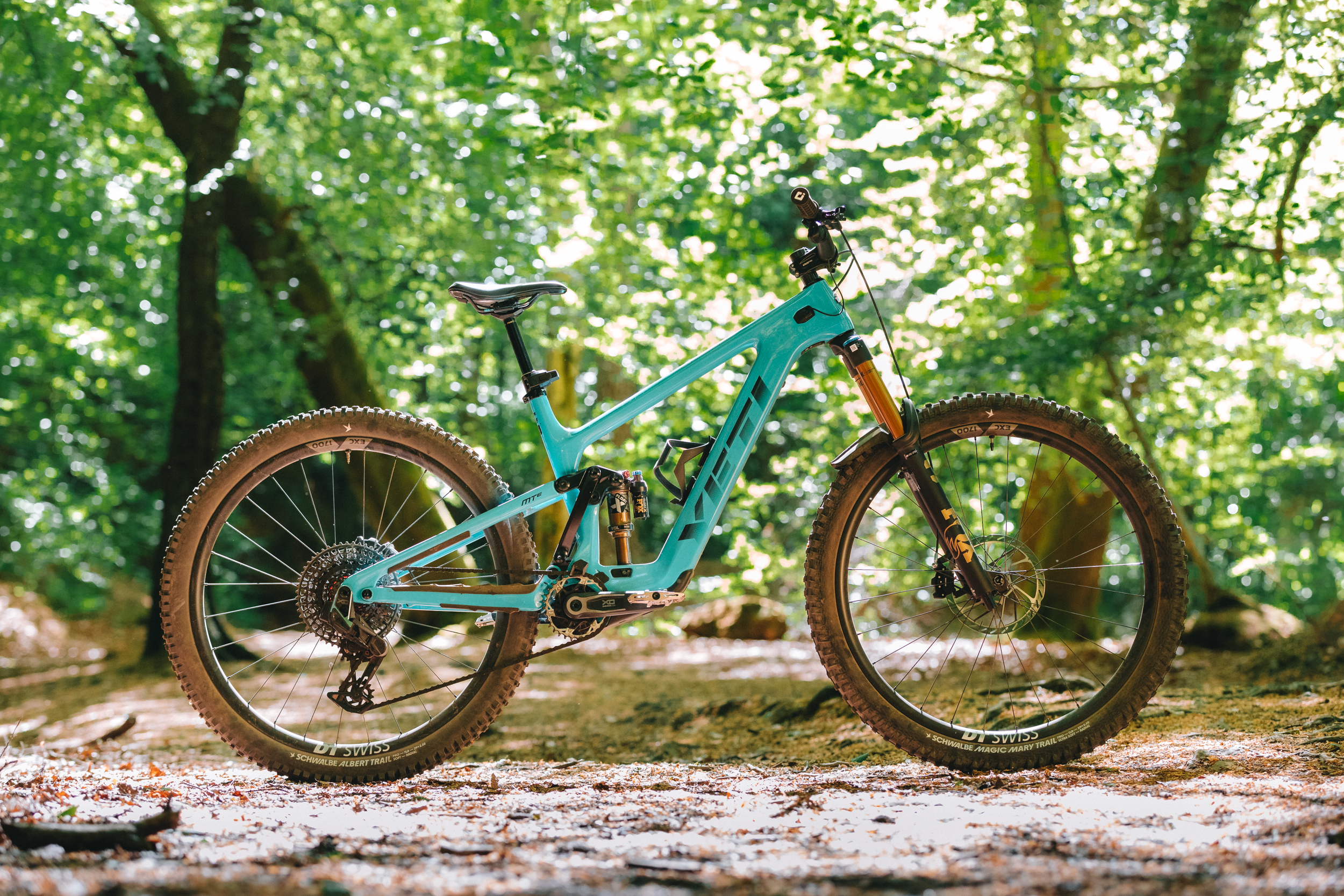
There’s nothing radical about the Yeti MTe geometry, but I preferred it with a 27.5in rear wheel in the 29in geo setting.
Geometry
Across the four available frame sizes, reach spans from 430mm to 505mm, with slightly closer gaps between the most popular medium and large frame options. I rode the size large with a claimed 480mm reach, I’m 5ft 10in, and it felt perfect for me.

With less mass to throw around, the Yeti MTe never lacks dynamism.
Other important numbers include a 64º head angle, 77º effective seat angle, 449mm chainstays on all sizes, and a 342mm BB height. Of course I didn’t take the published geo at face value – I measured my test bike in the workshop. As it happens, all of Yeti’s numbers are pretty much bob-on. But I also measured the MTe with a 27.5in rear wheel fitted (more on this later), without correcting the geo using the flip chip. This gave me a 62.9º head angle, 76.3º effective seat angle, and a 329mm BB height. Too extreme for some, perhaps, but for me this set-up took the MTe performance to another level.
In terms of weight, the large MTe in T3 X0 spec came in at 20.34kg. Definitely not heavy. But not exactly light, either. And travel was bang on the money – 145mm – requiring a fair effort to get the O-ring to slide off the end of the shock body, indicating full travel had been achieved.

Deeper cooling fins should help with thermal management – previous TQ motors we’ve tested got really hot.
Motor and battery
In terms of assistance, the 160E used Shimano’s EP8 motor hooked up to a 630Wh internal battery. The MTE gets TQ’s evolution of the diddy HPR50, now packing a much more useful 60Nm of torque and 350W of assistance (the HPR50 never felt like it really delivered the numbers it claimed).

The push-in rubber charging port cover works well enough, but doesn’t feel like a solution worthy of an £11k bike.
But perhaps the most important upgrade from TQ is the 580Wh internal battery. Range was by far the Achilles heel of the compact German drive unit, and that is absolutely no longer the case. I speak from experience here, as I’ve done over 300km on the Trek Slash + with the same battery, and over 80km on the Yeti MTe. With the 580Wh battery, appropriate tyres, a 80Kg rider on board, and using the Mid and High modes, 1,400m of climbing is easily possible. More if your route is mostly up and down the same hill.

TQ’s new colour screen is easy to read – a nice upgrade.
Further improving the scope of the TQ system is the 160Wh range extender and optional lightweight 290Wh internal battery. Having spent some time using the range extender, an extra internal battery would be my recommendation. Not only is it better value, but you have options to tune the weight and dynamics of your bike, and you don’t have to sacrifice the convenience of carrying a water bottle.

Remove the motor guard at the base of the down tube and you can slide the battery out.
Further updates to the TQ system include a revised motor casing, with additional cooling fins, a new colour screen integrated into the top tube, and a revised app that makes customising modes and changing settings, much simpler.
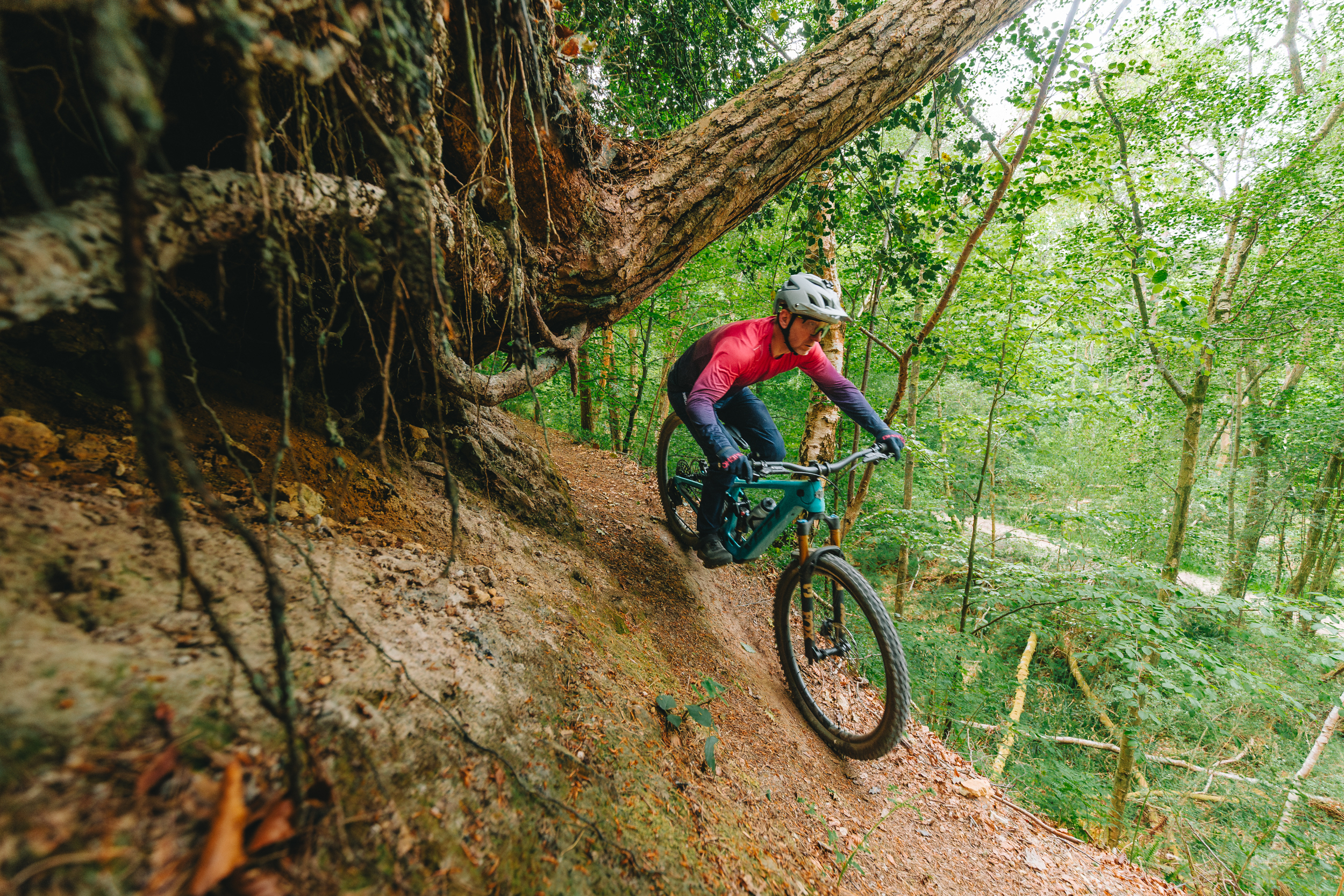
TQ talks a lot about ‘natural’ assistance. Basically that means it doesn’t give anywhere near the power of the full-fat e-bike.
Overall, it’s no DJI-killer, but it’s really light at 4.6kg for the motor and battery, super compact, ultra quiet, and now efficient enough to go the distance while giving an appreciable level of assistance.

RockShox’s new Reverb is fantastic, adding an extra layer of comfort when seated. Which you do a lot on an e-bike.
Components
Let’s start with the things I didn’t like. Mostly that boils down to the rear wheel and tyre combo. In some ways it makes sense that Yeti has chosen a fast-rolling Schwalbe Albert tyre at the back – this is effectively a trail bike after all, where speed and range are important – but for the steep South Wales trails I rode it on, there was neither the sidewall support or traction the bike deserved. And that’s climbing traction and braking traction, to the point where the rear tyre was the limiting factor on the severity of climb I could take on. When descending, there was no way of really arresting my speed in the loose conditions, because the powerful SRAM Maven brakes would overcome the grip at the slightest effort. And the flimsy sidewall casing would squirm unpredictably when loaded up in turns.

Fox has reduced friction in the MY26 36 forks, and they are so much better for it.
What stood out on the MTe was the RockShox Reverb post, which despite its slightly kooky looks thanks to the battery placement, is a revelation on flat, bumpy liaisons where I could stay seated and maintain a nice steady cadence without continually being knocked off my perch.

The Yeti MTe was a total blast to ride – after a few mods.
Performance
Apologies for persisting with my football analogy from the intro, but riding the Yeti MTe was a game of two halves. In the stock setting, on the steeps and jumps of South Wales, the sublime suspension was hampered by the inappropriate tyre choice and 29in rear wheel. A few days later, I chucked a 27.5in rear wheel in shod with a rear tyre boasting a paddle tread and a reinforced casing, and it was a completely different beast. Allow me to elaborate.

Traction was limited by the fast-rolling rear tyre.
Climbing
With the 29in wheel, the Yeti rolled efficiently up mellow climbs blessed with smooth surfaces, helped by the nicely stretched seated position, fast rolling tyre, and efficient suspension. But on steeper climbs with loose surfaces it was difficult to maintain traction. One particular climb that cut across the hillside we’d just ridden down, where the shallow gulley was strewn with loose rock, I found it really tricky to juggle my torque inputs with the balance between traction and a front wheel that wandered left and right. Because the motor doesn’t put out the torque to turn 34×52 gear on a steep slope, you have to make up the shortfall, and to do that you need to run the saddle high. Which means your centre of gravity is also high, and further back than optimal. So the bike just wants to tip backwards. Throw in a tyre with no paddles and it’s a real challenge. I made it up the climb, just, but Jamie didn’t, and was forced to use the walk mode.
Switching to the 27.5in rear wheel didn’t help my riding position on those steep climbs, but the Minion DHR II-alike tyre at least meant I could just churn away and not worry about traction.

With an MX-makeover and burlier rear tyre, the MTE really came into its own.
Descending
While the 27.5in rear wheel didn’t do much for the MTe’s climbing prowess, it had a marked effect on the descents. Not that I didn’t have a blast riding it as a full 29er, but the reduced bum clearance, extra wheel flex (the spokes were also a bit under-tensioned on the 29in wheel) and slight reluctance to turn in on steep corners just chipped away at my experience. Going MX turned the Yeti into a total ninja on tracks more appropriate to an enduro bike than anything all-mountain. And the key for me was not correcting the geometry. Yes, I left the bike in the 29in setting and sucked up the low BB height and slack head angle. I fully appreciate that 329mm is too low for some people, and that 62.9º is too slack, but I couldn’t get enough of the way the Yeti’s new stance let me tip into corners and charge into steeps. With the stiffer rear wheel, more predictable carcass, and aggressive tread, the MTe felt up for anything. Pedal strikes? I didn’t experience any, but I was being careful, and the trails weren’t that chunky.

Plenty of length in the bike, and a nice centred riding position made the MTE balanced and predictable.
But it wasn’t just the geometry that instilled confidence and inspired grins; it was the suspension. Oh my, Yeti has really nailed the suspension on this bike. To begin with it has delivered a superb tune on the rear shock. Buttery smooth, more animated than anything out of the Pixar studio, and beautifully controlled. There’s loads of support to pump undulations, a pop so fizzy it makes champagne look flat, and a dense, pillowy sensation at bottom-out on the harshest drops. For once I didn’t have to run the Fox Float X shock wide open on rebound either, and this light damping tune was matched by the extremely supple and active response from the latest 2026 Fox 36 Factory Grip X2 fork. Fox has really made huge strides with this new fork, and it all seems to be down to its efforts to reduce friction.
Verdict
Time to return to my original questions, and let’s start with ‘is it any good?’ The answer is, yes, it’s bloody brilliant. Well, once you turn the MTe into a mullet bike and put a decent rear tyre on. But perhaps the question I should have posed is, ‘is it good enough?’ That’s not so easy to answer, since this is an extremely expensive bike (basically £11k remember) and it doesn’t have anywhere near the power or range of something with a DJI motor. So I think it will have limited appeal outside the bubble of Yeti fan boys and girls. Luckily for Yeti there are a decent number of those. And to my second question, ‘has TQ improved the weakness of its system – namely power and range?’ My answer is also emphatically, yes. But again, I fear that it’s going to have a tough time turning people’s attention away from full power systems, now that you can get a full fat e-bike and only take a 1kg hit on the overall weight. Talk about brutal, but that’s the harsh reality of the market right now.









